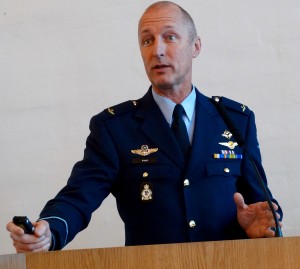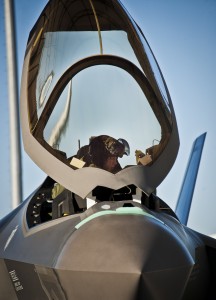2015-04-29 The Royal Dutch Air Force (RNLAF) has selected the F-35 as its next generation aircraft.
Indeed, the Norwegians and the Dutch are both planning to be an all-fifth generation fleet.
Others might join them in Europe as well in this process.
The Italian and the UK Air Forces will fly a mixed fleet of Typhoons and F-35s are they are working cross integration approaches, with the RAF notably interested in sea- and air-based aircraft integration in operations.
Initial training for all F-35A users — such as Italy and the Netherlands — will be conducted with the USAF at Luke AFB, and currently Dutch F-35s are located at Edwards AFB and are part of the overall roll out of the F-35A into the fleet.
At the Centre for Military Studies-Williams Foundation Airpower Symposium held in Copenhagen on April 17, 2015, Air Commodore Dré Kraak, from the Royal Netherlands Air Force, discussed the way ahead with regard to training for the Dutch Air Force and highlighted an important evolving coalition relationship with Italy.
Not only will Italy build the bulk of the Dutch F-35s, but they are also emerging as a key partner in possible training solutions as well.

And the Air Commodore went out of his way to praise the Italians, who in his words, “have seen dramatic progress in their aerospace production capabilities over the past twenty years.”
He started his presentation by highlighting that the Dutch selection of the F-35 was a no brainer.
It was by far the best aircraft in the competition.
Without any doubt, without any doubt operationally, the F35 is the best airplane ever.
And anybody that chooses something else– it’s probably a political choice and not a decision being made by a fighter pilot.
There’s no fighter pilot in the Dutch Air Force that does not think that the F35 is the best aircraft in the world at this moment.
The globality of the F-35 is important as well to the RNLAF.
“We want a plane that can be maintained worldwide as we don’t know where our next operation will be.”
Clearly, the Dutch intend to operate their F-35s in a coalition and Air Commodore Dré Kraak emphasized that like the F-16, the F-35 has coalition enablement built in.
The first Dutch F-35s will start arriving in 2019 and the RNLAF is working out how to operate differently as these planes start arriving and operating.
Logistics is part of this and they will build logistics support structures that will be part of the global supply system for the airplane.
But in a vein similar to that of John Blackburn, Kraak highlighted the need for rethinking and innovation within the Dutch Air Force to leverage the F-35.
The Chief of the Dutch Air Force talks about Air Force 3.0 as the need to reshape our approaches and our thinking about how to operate in the future.
We are a small Air Force: 7500 people and 65 fighter pilots.
Obviously, we have to innovate to get best value out of this force with our initial 37 F-35s.

The training side of the picture is rooted in part in the desire to have F-35s involved in operations and not being tagged for training.
What a lot of people don’t understand is that if I have less aircraft I can train less pilots.
And it’s not about the aircraft.
It’s about how many pilots can I use, how many pilots can I get trained.
So, if I have less F35s, I need to find an alternative to make sure that I can train those 65 combat ready pilots good enough.
And this leads to either the acquisition of new trainer aircraft or participating in a joint training program.
According to the Air Commodore:
I’m looking very much to an aircraft that can be very easily used next to an F35; not exactly the F35 cockpit, but for instance the M-346 might be a good choice for the training missions.
Because the USAF will not have a new trainer until the next decade, and its cost undetermined, the Dutch need to look elsewhere.
The program is simply too late for their needs.
He visited Italy last year with the Dutch Chief of Staff and they were very impressed with the M-346.
They are also looking at civilian business training solutions, which could use this airplane as well.
He highlighted cost as a key concern:
It’s a cheap airplane for training. It’s a very cheap airplane.
Right now it is about 8,000 to 9.000 Euros per hour that includes everything
He is also looking for European-wide solutions and has spoken with a number of European Air Forces about cooperative training possibilities.
Notably, he is looking to the possibility of building on the success of the common European Air Transport Command to come up with a European Aircrew Training Approach to share costs and experiences in shaping a way ahead.
In a bio through 2014, Air Commodore Dré Kraak’s background was described as follows:
Air Commodore Kraak started at the Military Academy in the Netherlands in 1980.
He became a fighter pilot in 1984.
Up through 2005 he accumulated a total of 2500 flying hours on the F-16 as a weapons- and flight instructor.
He served as an F-16 flight commander for several years at 311 Squadron and 323 Top Gun Weapons School.
He served there as the commander of the Dutch Weapons Instructor School (The Dutch Top Gun).
After this Air Commodore Kraak was employed at the RNLAF HQ at the F-16 Operational requirements section, responsible for the purchase of F-16 weapons.
He attended the Advanced Staff College in 1996, after which he was appointed as Commander of the RNLAF F-16 Detachment in Italy for operations over Bosnia in the rank of Lt. Col.
From June 1997 until March 2000 Air Commodore Kraak was the Squadron Commander of the 306 Tactical Fighter & Reconnaissance Squadron.
In the summer of 1999 he served as Chief of the Planning Cell at the CAOC in Vicenza (Italy) during the Kosovo war.
In April 2000 Air Commodore Kraak was promoted to Colonel and given the job as Chief of the Fighter Branch at the RNLAF HQ in The Hague.
He attended the NATO Defence College in Rome from Aug 2003 until feb 2004.
After this Air Commodore Kraak was appointed Chief of the Operational Requirements and Policy Branch in the Air Force HQ again.
In March 2005 he was appointed Commander of Soesterberg Airbase, the transport helicopter base in the Netherlands.
In this job he flew Chinook, Cougar and Alouette helicopters. In July 2007 Air Commodore Kraak was promoted to his present rank and installed as Deputy Director for Requirements at the Netherlands MOD.
During 2011 a major restructuring of the Dutch Armed Forces started in which Air Commodore Kraak got the job to reorganize the IT units in the MOD and to form a Joint IT Command.
Since May 2012 he also was appointed Deputy Commander and COO of the IT Command.
http://www.amiando.com/CIOCITY14.html?page=1073718
Currently, he is Project Manager European Aircrew Training Center at Koninklijke Luchtmacht.

